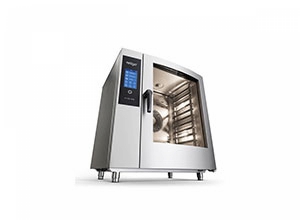CORRECT INSTALLATION OF A CONVECTION OVENS
For trouble-free operation of the Vision combi ovens and DeliMaster ovens (referred to as “appliances” below) and to prolong the durability of their components, they must be installed according to the currently applicable Technical and Service Documentation (TSD) intended for the specific appliance.
Keep in mind that correct installation fundamentally affects the product’s reliability. This strengthens the brand’s positive image, lowers the cost of providing the warranty, and most of all, considerably lowers the risk of operating personnel injury.
The appliance is to be installed only by personnel trained by the manufacturer and qualified to perform the individual technical tasks according to locally valid legal regulations.
Installation tasks can be divided into several sections. Please keep in mind that this is just a simplified overview. To install the appliance properly, it is always necessary to follow the instructions stated in the TSD.
1. Setting up the appliance properly
- Put the appliance on a solid, even surface — easier handling for operating personnel, less risk of injury.
- Set the appliance up on a levelled surface — better cooking results, less risk of employee injury.
- Adjust the door — easier handling for operator, longer door seal durability, less risk of leakage, less risk of the door lock mechanism damage, less risk of destroying the interior glass.
2. Connecting the electricity (can be done only by appropriately qualified technician)
- Connect the appliance only to a power supply that matches the data on the appliance’s production plate.
- To connect the appliance, use only the supply cables and circuit breakers indicated in the TSD.
- For safe operation, use all safety equipment prescribed against electrical injuries — residual current device, protective interconnection.
3. Connecting the gas (can be done only by appropriately qualified technician)
- Connect the appliance only to the type of gas indicated in the data on the production plate.
- Check whether the gas shut-off valve is easily accessible and close to the appliance.
- Check the appliance’s configuration in Service Menu is correct.
- Measure the gas pressure on the gas valve with the appliance turned on, and check whether it is within the range specified in the TSD (even in the event of a drop due to increased gas consumption).
- Check for leaks at the gas connection point and the gas distribution system inside the appliance.
- Measure the CO₂ concentration in the flue gas and check whether it is within the range specified in the TSD. If it isn’t, correct it at the gas valve.
4. Connecting the water and the drain
- The water connection must meet the requirements stated in the TSD (if it doesn’t, an appropriate treatment device must be connected to the water supply line). If the water is harder than 5 °dH a water softener must be installed on water supply in front of it. It is always necessary to install a water sediment filter with a maximum calibre of 80 μm. The manufacturer is not liable for damages caused by water quality not meeting the manufacturer’s requirements!
- Check the input water pressure.
- Set the proper water pressure at the pressure regulator according to the size of the appliance, and measure whether the injection pipe’s water flow per minute complies with the TSD (does not apply to appliances with a boiler).
- When connecting the appliance to the drain pipe, it is necessary to follow the requirements in the TSD, especially: length of drain tube, min. diameter of drain pipe and its gradient.
- Before turning the installation over to the customer, the humidity sensor must be calibrated (does not apply to Orange model).
